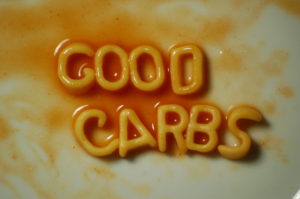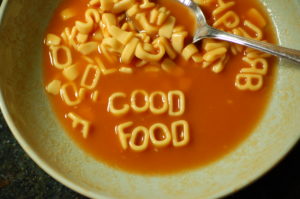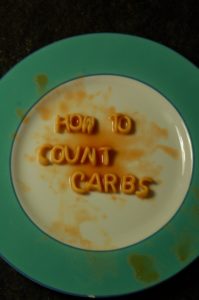 As a diabetic, your diet can become one of the most challenging aspects of your blood sugar control. Carb counting is an effective approach that can help while allowing plenty of flexibility when it comes to food. Whether you are already a carb-counter or not, here Eleana Papadopoulou, dietitian with www.carbsandcals.com gives us a refresher on modern methods and insights.
As a diabetic, your diet can become one of the most challenging aspects of your blood sugar control. Carb counting is an effective approach that can help while allowing plenty of flexibility when it comes to food. Whether you are already a carb-counter or not, here Eleana Papadopoulou, dietitian with www.carbsandcals.com gives us a refresher on modern methods and insights.
“The three main nutrients in the food we eat are carbohydrate, protein and fat. Carbohydrate is the nutrient that is mainly responsible for the rise in blood glucose levels that occurs after eating. A specific carbohydrate portion will therefore raise blood glucose levels by a certain amount. In type 1 and sometimes in type 2 diabetes, an insulin dose that is proportional to the amount of carbohydrate consumed needs to be injected, to prevent blood glucose levels from rising above the normal range. Carbohydrate counting is the process of matching or adjusting an insulin dose to the grams of carbohydrate consumed at each meal or snack.
A little bit of history….
Carbohydrate counting is not a new concept; it has been around since the discovery of insulin back in the 1920’s. Insulin treatment at that time did not allow for any dietary flexibility and carbohydrate counting was used as a means of restricting carbohydrate intake to match fixed insulin doses. Its popularity was challenged in the 1980’s, when the then British Diabetic Association (now Diabetes UK) published policy recommending that people with diabetes should follow the same healthy, balanced diet as the non-diabetic population. This policy, however, downgraded the importance of carbohydrate counting in the management of diabetes. It was not until a decade ago that carbohydrate counting made a huge comeback and nowadays it constitutes the largest component of diabetes education and management.
Carb-counting is back for three reasons:
- The development of more sophisticated insulins, provided greater flexibility, enabling people to match insulin doses to the amount of carbohydrate consumed, instead of eating set amounts of carbohydrate to match fixed insulin doses.
- Structured education programs like the Dose Adjustment for Normal Eating (DAFNE), focused attention on carbohydrate counting as a means of empowering people with diabetes and improving self-management skills.
- Evidence from randomised controlled trials showed that carbohydrate counting not only optimises glycaemic control, but also improves quality of life and general wellbeing without increasing severe hypoglycaemia, blood lipid levels or body weight.
It is therefore a skill worth focusing on, and mastering!
 Which foods contain carbohydrate?
Which foods contain carbohydrate?
Carbohydrate is an important source of energy. During digestion it is broken down into glucose, which enters the bloodstream and is taken up by the cells of the body to use as fuel. Carbohydrate comes in two forms, starch (or complex carbohydrate) and sugars (or simple carbohydrate).
Starchy carbohydrates include foods like bread, rice, pasta, potatoes, noodles, yam, chapattis, grains and cereals. Sugars include table sugar (caster, granulated, etc.), sugary foods and drinks such as honey, jam, biscuits and soft drinks. Sugars can also be found in fruit (fructose) and in some dairy foods (lactose) such as milk, yogurt and ice cream.
Vegetables also contain carbohydrate, but as they are very slowly absorbed they usually do not need to be counted, unless the portion size is particularly big.
Is carb counting hard?
To achieve blood glucose levels within the normal range, an in-depth knowledge of the carbohydrate content of food and drink is required. This is itself somewhat challenging. It requires time and effort, some mathematical ability and a good understanding of the amount, type and timing of carbohydrate intake. Dedication to frequent blood glucose monitoring is also important as well as solid knowledge of the action of insulin and how to adjust it appropriately.
A variety of methods can be used to count the carbohydrate content of food and drink and a number of tools make this possible. It would be worth trying all the different methods and choosing the ones that work best for you and suit your lifestyle.
How does it work?
If you are on insulin, a factor that can affect your success at carb-counting is to have the correct basal insulin worked out – this is either your long-acting insulin, or if you are on a bump, then your basal rates plugged into your pump. This may however get adjusted over time as you acquire better carb-counting skills.
Getting the carbohydrate right is also a factor, as not all food/drink contains the same amounts of carbohydrate. It is important to establish which components of your meal have carbohydrate and which of this carbohydrate needs to be counted. Carbohydrate is usually estimated either in carbohydrate grams or as carbohydrate portions (CPs). One CP contains 10g of carbohydrate. For example, 100g of oven chips contain 30g of carbohydrate or 3 CPs. Some diabetes centres use CPs and some work in grams of carbohydrate.
Once you have estimated the carbohydrate content of your meal, it is time to calculate your bolus insulin dose. And this is simple! The more carbohydrate you eat, the greater your bolus insulin requirements; the less carbohydrate you eat, the lower your insulin requirements; if you have no carbohydrate or negligible amounts, then no insulin is required. To work out your bolus insulin requirements, you need to know your ‘insulin-to-carbohydrate ratio’, which represents your insulin requirements for a specific amount of carbohydrate. Usually, 1 unit of insulin is required for every 10g of carbohydrate or 1 CP. This ratio of course differs from person to person and can also vary at different times of the day. Consult your diabetes team, who will ensure that your insulin-to-carbohydrate ratio is correct. If your insulin-to-carbohydrate ratio and carbohydrate counting are correct, your blood glucose levels before the next meal should be between 4-6 mmol/l.
 Can I do it?
Can I do it?
Initially, you may want some support from your healthcare professionals, such as your diabetes specialist nurse or dietitian. You may be able to attend one of the diabetes education courses that are widely available. The most recent guidelines for diabetes management recommend that people on multiple daily injections and insulin pumps should be offered structured diabetes education from the time of diagnosis onwards. Ask your healthcare professional for advice on which education course is offered at your diabetes centre.
Any drawbacks?
One disadvantage of carbohydrate counting is that by focusing only on carbohydrate, it is easy to lose sight of the overall nutrient composition of your diet. For example, it is common to overlook the fat and calorie content of food and this may lead to undesirable weight gain and to increased risk of heart disease and cancer. Don’t forget to take into consideration all the nutrients that comprise food, and not only carbohydrate, when deciding what to eat and your portion sizes.
So what are you waiting for? Start carbohydrate counting today!
Further reading and resources:
Carbs & Cals – Book & App (with over 1,200 food & drink photos) for people with diabetes
http://www.carbsandcals.com
DAFNE
http://www.dafne.uk.com/
Diabetes UK
http://www.diabetes.org.uk/
NICE guidelines
http://www.nice.org.uk/nicemedia/pdf/CG015adultsquickrefguide.pdf
Food features and recipes like this appear in the Desang Diabetes Magazine, our free-to-receive digital journal. We cover diabetes news, diabetes ‘kit’ and information on food suitable for maintaining good blood glucose control or a diabetic diet, including a regular Making Carbs Count column. It’s free! Go to the top of this page to sign up – we just need your email address. See current and past issues at
www.desang-magazine.co.uk
Open publication

